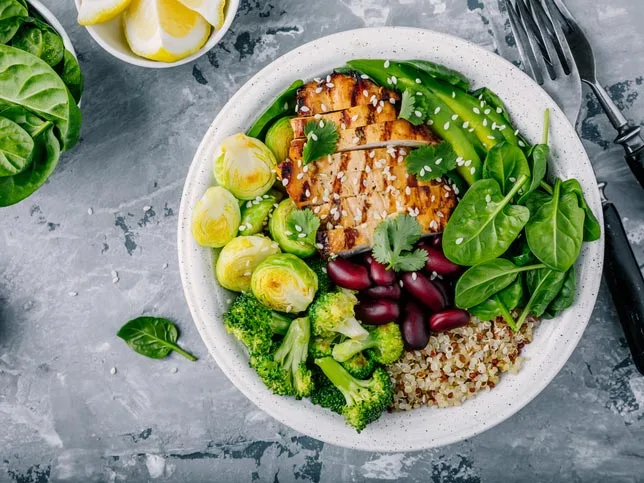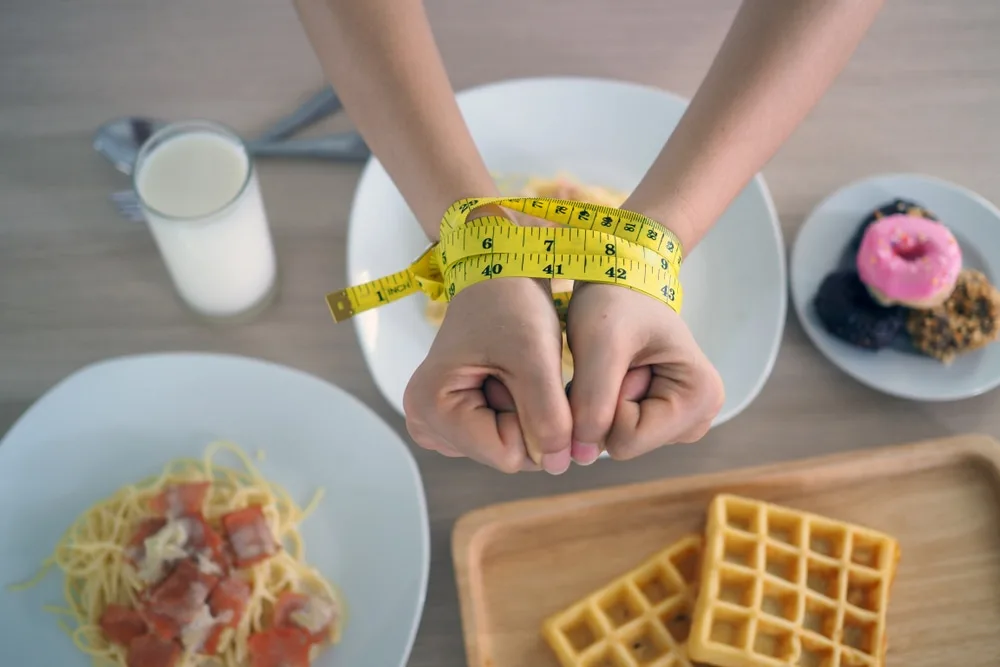Eating appropriate portion sizes is a key element of any effective weight loss regimen. Proper portioning helps maintain a healthy calorie balance and prevents overconsumption – critical factors with rising obesity rates worldwide. This in-depth blog shares 9 expert strategies to master meal portioning for successful, sustainable weight loss.

Understanding Portion Sizes vs. Serving Sizes
It’s easy to confuse “portion” and “serving” sizes. A portion is the amount of food you choose to eat at one time. Serving size refers to the recommended amount listed on a product’s nutrition label. Many people habitually eat larger-than-recommended portions, driving excess calorie intake. Studies indicate portion sizes have steadily increased over the past 30 years, with larger plates, cups, bowls and utensils contributing to overserving and overeating. Jumbo portions have become the norm.
When trying to lose weight, it’s important be aware of appropriate single-serving portion sizes as well as the calorie density in foods. Lower calorie options like fruits, vegetables and broth-based soups should make up a greater portion of your plate. Higher calorie foods like meat, cheese, and rich sauces come in smaller portions. Focus on reasonable portions to manage calories.
The Simple Plate Method for Balanced, Portion-Controlled Meals
The plate method is an uncomplicated, visual technique to build balanced, portion-controlled meals. Simply divide your plate into sections for protein, non-starchy vegetables, and carbohydrate foods. As a general guideline:
- Fill half your plate with non-starchy vegetables and fruits. These provide nutrients, fiber and volume while keeping calories in check.
- Devote one quarter of the plate to lean protein foods like chicken, fish, beans, tofu or eggs. Protein foods promote fullness, help retain muscle mass when losing weight, and stabilize blood sugar.
- The last quarter of the plate should contain whole grain carbohydrate foods like brown rice, quinoa, whole wheat pasta or starchy vegetables. Limiting carbohydrates controls overall calories in the meal while still providing important fiber.
Creating meals with a healthy balance of plant-based proteins, smart carbs, and nutrient-dense produce ensures satisfying portions that keep you full while delivering balanced nutrition.

Using Hand Portions for Practical, Visual Serving Size Guides
Your hands can serve as convenient everyday visual guides for estimating well-balanced portions.
- To gauge appropriate protein servings, use the palm of your hand, excluding fingers and thumb. A palm-sized serving provides 3–4 ounces of protein depending on your hand size. This equals about the size of a smartphone.
- For carbohydrate servings like grains or starches, a loosely closed fist equates to one serving. This amounts to around 1⁄2 cup or 30–40 grams of carbs.
- A thumb tip demonstrates approximately one teaspoon of added fats and oils. Stick to just 1-2 thumb tips per meal.
- When dishing up non-starchy vegetables, a cupped hand equates approximately one cup. Go for 2–3 cupped handfuls per meal.
Adjust portion sizes based on your own hand measurements, hunger levels, and weight loss goals. For instance, larger, active individuals may require somewhat bigger portions than smaller, sedentary people trying to shed pounds. Using your hand as a visual gauge takes the guesswork out of how much to eat. Just be sure to actually measure with your hand instead of just eyeballing amounts. With practice, picturing proper hand-sized portions becomes second nature.
Eating Mindfully for Weight Loss: Greater Portion Control
Mindful eating means being actively aware of the eating experience – eliminating distractions, paying full attention to physical hunger and fullness cues, chewing thoroughly, and eating slowly without overindulging. Studies show that those who eat mindfully consume up to 70 percent fewer calories per meal.
Here are some tips to become a more mindful, intuitive eater:
- Avoid eating while multi-tasking. Don’t eat in front of the TV, computer or phone. Sit down at a table without distractions to fully focus on your food.
- Pause before eating to tune into physical hunger signals. Rate your hunger on a scale of 1-10. Only eat when truly hungry, stopping when comfortably satisfied.
- Take small bites, chew thoroughly, and intentionally pause between bites. Check in on how full you feel throughout the meal.
- Use smaller plates and bowls, which can trick your brain into thinking portions are bigger than they really are.
- Eat slowly, setting utensils down between bites and resisting the urge to rush through meals.
The more conscious you become of portions, textures, flavors and hunger cues, the easier it is to recognize feelings of fullness and avoid unconscious overeating. Mindfulness brings greater satisfaction and portion control.

Reading Food Labels for Helpful Portion Information
Nutrition labels on packaged foods provide valuable data to help determine appropriate portion sizes. Here’s how to interpret them:
- First, pay attention to the serving size listed. This indicates the amount of food considered one portion or serving.
- Also note the number of servings per container. For example, a bottle of soda or a bag of chips may contain 2, 2.5 or even 3 servings.
- Remember, the calorie and nutrient information listed is for one serving only. You need to multiply accordingly if you are consuming larger portions.
- Compare serving sizes of similar products to make better informed comparisons and choices.
- The percent Daily Value (%DV) metrics indicate if a food is high or low in a particular nutrient. Use this data to evaluate nutritional quality within a serving.
Taking the time to properly read and comprehend food labels leads to better portion awareness and control. You’ll know exactly how much of a food equates to one serving and can determine reasonable portions.
Pre-Portioned Options for Mindless Portion Control
For convenient, fuss-free portion control, take advantage of single-serve items and pre-packaged meals with perfectly portioned ingredients. Relying on ready-to-eat items can simplify portion management:
- Individually packaged snacks like yogurt cups, string cheese sticks, boiled eggs, cut veggies, hummus cups and nut packs make great grab-and-go options.
- Pre-portioned frozen meals, meal kits and heat-and-eat items like canned soups take the work out of measuring portions.
- When preparing foods at home, use smaller containers and lunch bags to avoid overstuffing meals and snacks.
- Invest in portion-control dinnerware like plates with built-in visual measurements or color-coded plates that coordinate to nutrition guidelines.
- When dining out, immediately box up half your restaurant meal when served to control portions.
Leaning on pre-determined portions from food manufacturers and restaurants eliminates the guesswork of how much to eat.

Seeking Guidance from Nutrition Professionals
For personalized portion advice, consider booking an appointment with a registered dietitian or qualified clinical nutrition professional. They can provide science-backed portion recommendations tailored to your age, activity level, metabolism, body composition, health status and weight goals.
A nutrition expert can objectively assess your current dietary habits and patterns to identify appropriate food group targets and serving sizes just for you. Regular check-ins over time can help adjust your personalized meal plan to ensure you’re eating enough – but not too much – to support weight objectives while optimizing nutrition. Accredited professionals also offer motivational support to implement changes.
Getting individualized portion guidance provides structure, accountability and expertise for portion control success. Most health insurance plans cover dietitian counseling for medical conditions like obesity, diabetes, high blood pressure and high cholesterol.
Strategies to Curb Emotional and Unconscious Eating
Stress, anxiety, boredom, loneliness and other difficult emotions can trigger emotional eating. This involves overindulging in calorie-dense comfort foods without actual physical hunger. Emotional eating is a common coping mechanism that provides temporary mood relief but sabotages weight loss efforts.
Practicing mindful, intuitive eating can help foster consciousness of how much and why you are really eating. Here are more ways to prevent stress-driven eating:
- Identify triggers and have a plan to deal with emotions constructively through exercise, meditation, calling a friend or journaling.
- Distract yourself with a hobby, walk or other activity instead of opening the pantry when stressed.
- Keep triggers like junk food out of the house and easy-to-eat fruits and veggies washed and visible.
- Practice self-care and prioritize sleep, relaxation and social connection to reduce stress.
- Seek counseling if emotional eating is significantly impacting health and quality of life.
By proactively addressing the root causes of stress and learning healthier coping mechanisms, it becomes easier to stick to portion control.

Making Gradual Changes for Sustainable Success
To make any new eating pattern stick long-term, it’s important to introduce portion changes gradually over weeks and months. Drastically slashing your portions overnight rarely leads to lasting success. It often backfires, resulting in intense cravings, feelings of restriction and binge eating.
Making small, incremental changes allows your body and mind time to adapt. For example, start by reducing portion sizes of higher calorie foods by 25%. Eat on the smaller end of your hand portion range. Downsize dishes and use portion-control dinnerware. Slowly add more vegetable portions to crowd out overeating. Drink water before meals and eat slowly.
Remember, large restaurant-sized portions have become the cultural norm. It takes time and consistency to adjust to appropriately sized meals again. Have patience, stick with small changes, and don’t rely on willpower alone. The goal is establishing sustainable habits – not short-term, draconian restrictions. With an adaptive approach, your new nourishing portion sizes will start to feel satisfying and maintainable for life.
Healthy Portioning Tips Summary
In summary, here are some top nutritionist-recommended tips for conquering portion control:
- Use a plate or food scale to understand recommended serving sizes
- Visually split your plate into balance protein, veggies and carbs
- Let your hand size guide reasonable portions
- Practice mindful, distraction-free eating
- Read nutrition labels for serving information
- Use pre-portioned meals and containers
- Seek guidance from a registered dietitian
- Identify emotional eating triggers and alternatives
- Make small, gradual reductions in portions for sustainability
Proper portioning is fundamental for weight management, disease prevention and overall health. But it doesn’t have to be complicated. Start applying these simple yet effective strategies to get on track with single-serving awareness and balance. Be consistent and be patient – long-term behavior change takes time. With mindful eating habits and proper food portions, you can achieve your health goals one bite at a time.
I hope these tips help you on your wellness journey! For extra support, be sure to sign up for our free newsletter packed with healthy recipes, wellness information and exclusive deals. We also have several other blogs covering food, nutrition, health, wellness and weight loss that can help. Together we can build balanced eating routines for life.
Thank you for reading this post, don't forget to subscribe to our free newsletter
!
